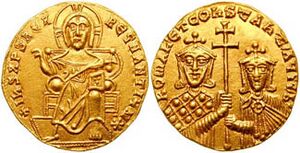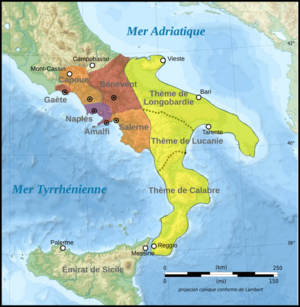Marianos Argyros facts for kids
Quick facts for kids
Marianos Argyros
|
|
|---|---|
| Died | 16 August 963 |
| Nationality | Byzantine |
| Occupation | Monk and later senior general in Italy and the Balkans |
| Years active | c. 944–963 |
| Parent(s) |
|
| Relatives | Romanos Argyros (brother) |
Marianos Argyros (Greek: Μαριανός Ἀργυρός, active around 944 – died August 16, 963) was an important person in the Byzantine Empire. He was part of the powerful Argyros family. Marianos started his life as a monk. But in 944, he helped Constantine VII become the sole emperor. Because of this, he was allowed to leave the monastery and join the emperor's service.
He became a top military leader. He fought in southern Italy against local rebels and the Fatimids. He also fought in the Balkans against the Magyars. In 963, he tried to stop a general named Nikephoros Phokas from taking the throne. Marianos tried to take control of Constantinople and arrest Nikephoros's father. During these fights, he was hit on the head and died the next day.
Contents
Marianos Argyros: A Byzantine General
Early Life and Political Changes
Marianos was the oldest son of a general named Leo Argyros. His family was very close to Emperor Romanos I Lekapenos (who ruled from 920 to 944). Romanos I had become emperor by sharing power with the young Constantine VII Porphyrogennetos (who ruled from 913 to 959). Romanos I wanted his own family to rule. He made his sons, Stephen and Constantine, co-emperors.
In 943, Emperor Romanos I decided that Constantine VII should be the main emperor after he died. This made Romanos's sons, Stephen and Constantine, very unhappy. They planned to take power for themselves.
Marianos Argyros is first mentioned in December 944. At this time, he was a monk. He was a trusted friend of Stephen Lekapenos. Marianos helped Stephen and Constantine remove their father, Romanos I, from power. Romanos I was sent away to a monastery.
However, just a few weeks later, Constantine VII managed to take control. The people of Constantinople supported him. Marianos changed sides and helped arrest Stephen and Constantine Lekapenos. They were also sent away. As a reward, Constantine VII, now the only ruler, let Marianos leave his monk life. He gave him a high rank and an important job. Because he left his monk's robes, people called him "Apambas."
Fighting in Southern Italy
Marianos then became a military commander. Around 955, he led troops to southern Italy. There was a rebellion in the Byzantine areas of Langobardia and Calabria. The city of Naples was also involved. Marianos's forces surrounded Naples until the city gave up.
Marianos then became the governor of the Byzantine provinces in Italy. In 956, he was known as the governor of Calabria and Langobardia. Around this time, a war started between the Fatimids and another group called the Umayyads. Marianos focused on stopping the rebellion in Italy. He sent people to the Fatimid leader, al-Mu'izz, to ask for peace.
But al-Mu'izz refused. He sent new forces to Sicily. In 956, the Fatimid fleet defeated the Byzantine fleet near the Straits of Messina. They also attacked the coast of Calabria. After these attacks, Marianos went to the Fatimid court himself. He offered to pay tribute and release prisoners for a truce. Al-Mu'izz agreed.
However, the fighting started again soon after. A Byzantine admiral destroyed a mosque and attacked another city. So, Marianos went back to the Fatimid court in 957. He brought a letter from Emperor Constantine VII. But this time, al-Mu'izz rejected the peace terms.
Because of this, Constantine VII sent a huge army to Italy. Marianos led the ground troops. The Fatimids won a battle against Marianos's forces. But then the Byzantine reinforcements arrived. The Fatimid fleet left Calabria and was shipwrecked on its way back to Sicily. Marianos is not mentioned in Italy after this. However, he might have gone on a third trip to al-Mu'izz in 958. This trip led to a five-year peace agreement.
Command in the Balkans and Death
Around 959 or 961, Marianos defeated a raid by the Magyars in Thrace. He took many of them prisoner. During this time, he was called a "monostrategos" of Macedonia and "katepano of the West." This meant he was in charge of all the Byzantine troops in Europe.
On March 15, 963, Emperor Romanos II (who ruled from 959 to 963) died suddenly. He left behind his young sons, Basil II and Constantine VIII, as emperors. A powerful general named Nikephoros Phokas decided to take the throne for himself. But the head chamberlain, Joseph Bringas, opposed him.
Bringas offered Marianos a high command if he would help him. Marianos first suggested trying to get Nikephoros Phokas's nephew, John Tzimiskes, to join them. But John Tzimiskes refused and told his uncle. Nikephoros Phokas then gathered his armies and had them declare him emperor.
As Phokas's army marched towards Constantinople, Marianos tried to take control of the city. He used soldiers from Macedonia and armed prisoners. But the people of Constantinople fought back. The crowds became very angry when Marianos tried to force Nikephoros Phokas's elderly father, Bardas Phokas the Elder, out of the Hagia Sophia church. This happened on August 15. Marianos was hit on the head by a platter thrown from a house roof. He was badly hurt and died the next day, August 16. After this, Phokas's supporters quickly won. Nikephoros Phokas was crowned emperor on August 16.




